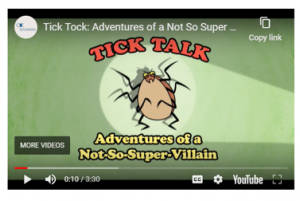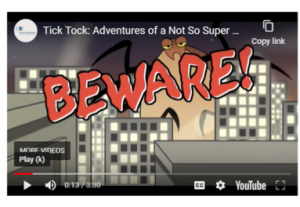Following our first in-class session, Chelsea drafted an example blog post to give a further example of the role of blogs in the course. The course blog is meant to be a space to reflect on what you are learning and to draw in your own examples to build relevance to the course content.
Communicating with Children
The BCCDC’s ‘Tick Talk’ (http://www.bccdc.ca/health-info/diseases-conditions/lyme-disease-borrelia-burgdorferi-infection/tick-talk) is aimed primarily at children and is intended to ‘encourage everyone to be aware of disease-causing ticks and prevention of Lyme disease that can result from a tick bite.’
I had some reservations about whether the ‘Tick Talk’ messages would be received by the target audience (ages 5-9) so I got feedback from my 6-year-old daughter.
Based on the BCCDC website, I understood the messages as:
- Don’t be scared of ticks but know that they can transmit disease, so protect yourself.
- Ticks can be found in long grass.
- Stay on a clear path, wear appropriate clothing, and use repellant.
- Check yourself for ticks and if you find one, remove it properly.
- Submit your tick to the BCCDC.
Before the video, I asked her what she knew or thought about ticks and she said:
- Ticks are bugs.
- They live under the ground.
- You don’t want them in your house.
After the video, I asked her what she learned and she said:
- Ticks are mean.
- Ticks live in the grass AND fall from the sky
- If you get a tick then you should go to your doctor – The last thing that was said in the video was to go to your doctor if you feel sick after getting bitten by a tick.
I found this surprising, and did some digging into how children receive and process information. Interestingly, I found that children under the age of eight don’t fully integrate what they are hearing and seeing, using the first visual cue their brain processes to make judgements about the situation as a whole (https://www.livescience.com/10753-brain-processes-images-differently-kid.html). This explains why my daughter got the opposite of the intended message – the first frame is of a tick acting like a monster, and subsequently she had a hard time integrating what she was seeing (tick acting like a scary monster, tick falling from the sky) and what she was hearing (don’t be afraid, ticks don’t fall from the sky).


Interestingly, my daughter also thought ticks were “mean”. It turns out that around the age of 4 or 5, children are able to understand and control their own behavior (https://www.jstor.org/stable/1449759?seq=1_) and also when they tend to project themselves onto inanimate objects, animals, etc., to make sense of the world. So, my daughter was projecting herself on to the tick because she would not bite someone unless to harm them.
I think the take home message is that you need to go beyond identifying your target audience – your communication needs to be designed precisely for how they think. Advertisers have long been enlisting the help of child psychologists to create effective marketing campaigns – so much so that the APA convened a task force on the ethics of using child psychology for advertising (https://www.apa.org/pi/families/resources/advertising-children.pdf). Despite an extensive search, I could not find any guidance documents on how to communicate science to young children. Definitely a gap to be filled!